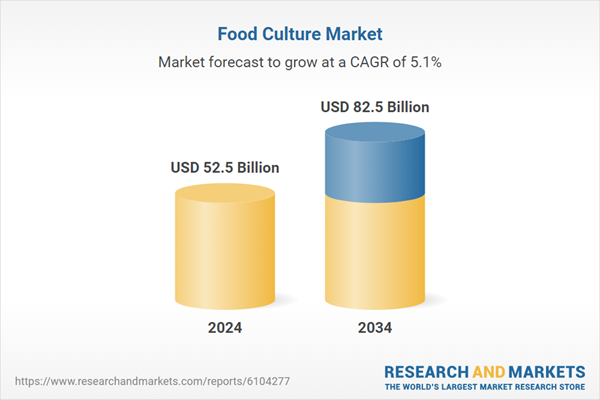The rapid expansion of the global food and beverage sector, particularly in emerging markets, further fuels this demand. Alongside this, rising interest in plant-based and clean-label products has accelerated the adoption of innovative microbial strains, made possible by advances in biotechnology and fermentation techniques. Regulatory backing and growing awareness of probiotics’ benefits also contribute to the steady expansion of this market.
The bacterial cultures segment dominated the market in 2024, capturing a 53.2% share with a valuation of USD 27.9 billion. Their widespread application in probiotic and starter cultures, essential for many fermented foods and drinks, underpins their leadership. Bacterial cultures are favored for their functional health advantages, particularly aiding digestion and gut health. Technological advancements in microbial development, vacuum sealing, and packaging have improved shelf life and preserved product quality. The rising consumer focus on clean-label, health-oriented foods has significantly boosted demand within this segment.
The dairy products segment represented a 44.08% share in 2024 and is anticipated to grow at a CAGR of 3.7%, broadening its consumer base. This segment dominates because cultured dairy items like yogurt and cheese enjoy widespread consumption and are increasingly valued for their probiotic and health-supporting properties. As consumers pay closer attention to digestion, immunity, and ingredient transparency, demand for dairy foods enriched with beneficial microbes grows. Innovations in fermentation technologies and increased investments in dairy culture development continue to drive this segment’s growth.
Asia-Pacific Food Culture Market held a 34.3% share in 2024. Countries within APAC, particularly China, India, and Japan, lead this market due to factors such as rising urbanization, population density, and shifting consumer tastes. Longstanding traditions of consuming fermented foods have established a strong base for fermented product demand. Growing middle-class populations and increasing disposable incomes drive higher purchases of functional and probiotic-rich foods. Health-conscious urban consumers, especially millennials, are fueling interest in gut health and clean-label products. The region’s rapid food processing growth and microbial technology advancements have enabled domestic producers to scale and market traditional food cultures effectively.
Key industry players contributing to innovation and distribution include Kerry Group, Chr. Hansen A/S, International Flavors & Fragrances Inc., Lallemand Inc., and Cargill, Incorporated. Companies in the food culture market focus on innovation and strategic partnerships to solidify their market presence. They invest heavily in research and development to create novel, more efficient microbial strains that enhance functionality and sustainability.
Expanding collaborations with food manufacturers helps integrate these cultures into a wider array of products, including plant-based and clean-label options. Geographic expansion, particularly into emerging markets, allows companies to capture growing demand fueled by rising urbanization and disposable incomes. Marketing efforts emphasize the health benefits of probiotics and natural ingredients, targeting health-conscious consumers.
Comprehensive Market Analysis and Forecast
- Industry trends, key growth drivers, challenges, future opportunities, and regulatory landscape
- Competitive landscape with Porter’s Five Forces and PESTEL analysis
- Market size, segmentation, and regional forecasts
- In-depth company profiles, business strategies, financial insights, and SWOT analysis
This product will be delivered within 2-4 business days.
Table of Contents
COMPANIES MENTIONED
The companies featured in this food culture market report include:- Chr. Hansen A/S
- International Flavors & Fragrances Inc. (IFF)
- Lallemand Inc.
- DSM (Now part of Firmenich DSM)
- Kerry Group
- Cargill, Incorporated
- Döhler Group
- Lesaffre
- DuPont (Now part of IFF)
- CSK Food Enrichment B.V.
- Sacco System
- Lb Bulgaricum Plc.
- Bioprox
- Biochem SRL
- Soyuzsnab
Table Information
| Report Attribute | Details |
|---|---|
| No. of Pages | 220 |
| Published | June 2025 |
| Forecast Period | 2024 - 2034 |
| Estimated Market Value ( USD | $ 52.5 Billion |
| Forecasted Market Value ( USD | $ 82.5 Billion |
| Compound Annual Growth Rate | 5.1% |
| Regions Covered | Global |
| No. of Companies Mentioned | 16 |









